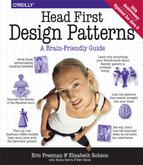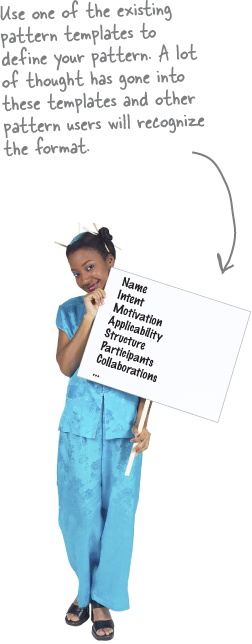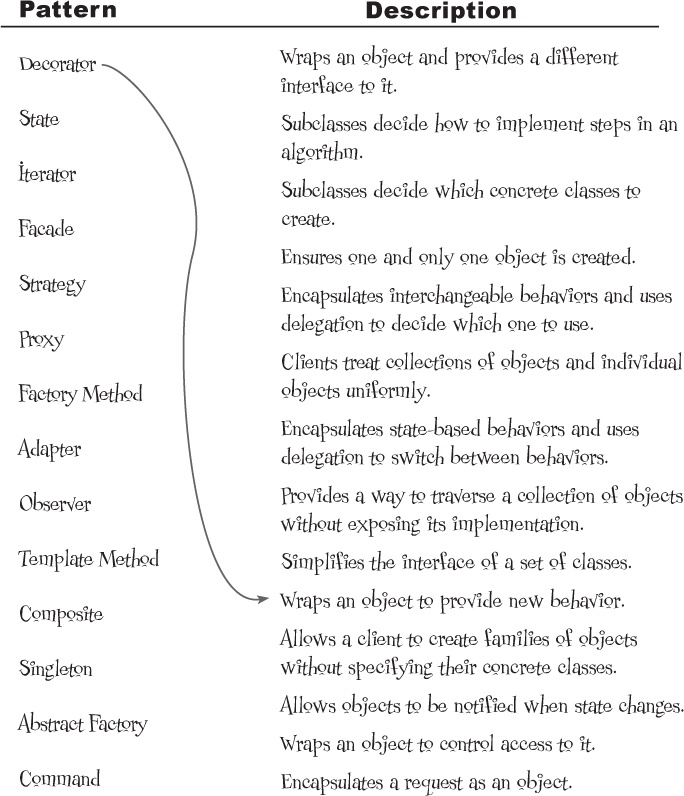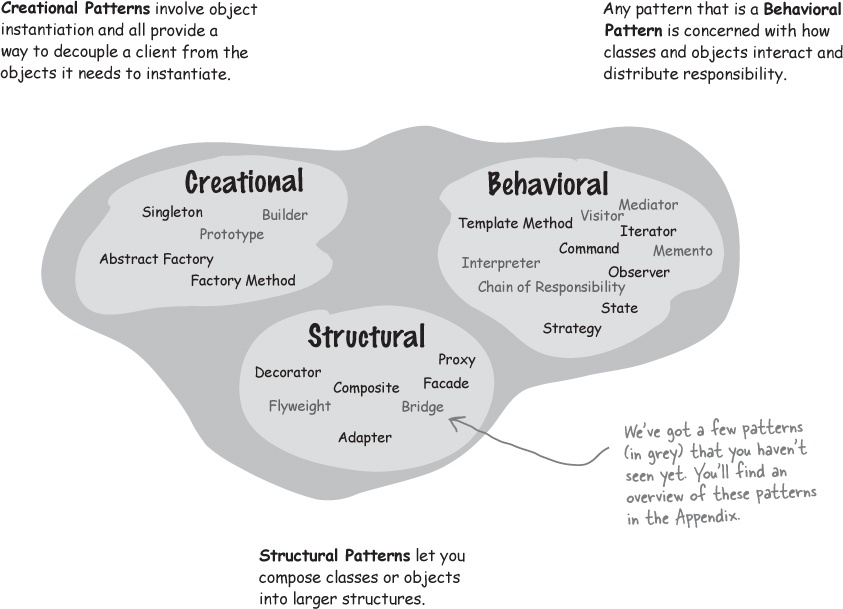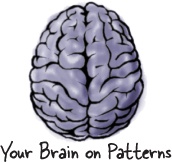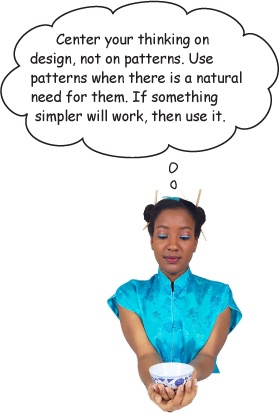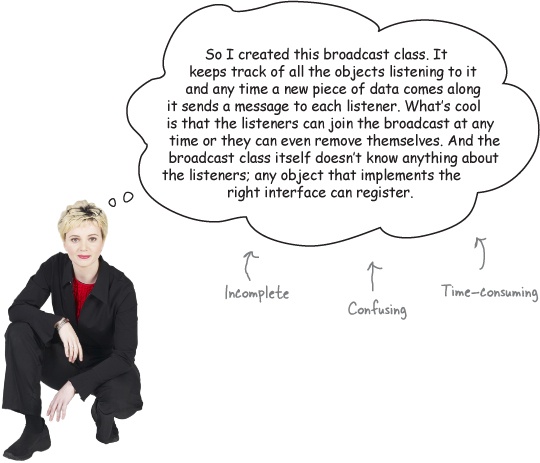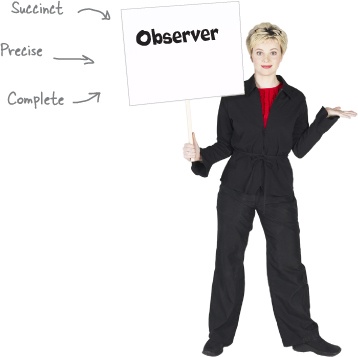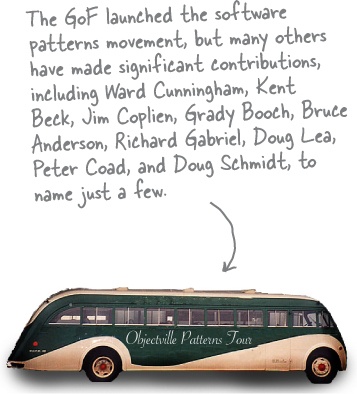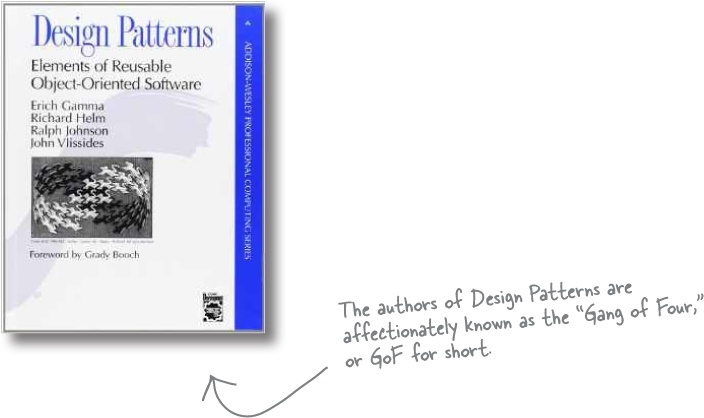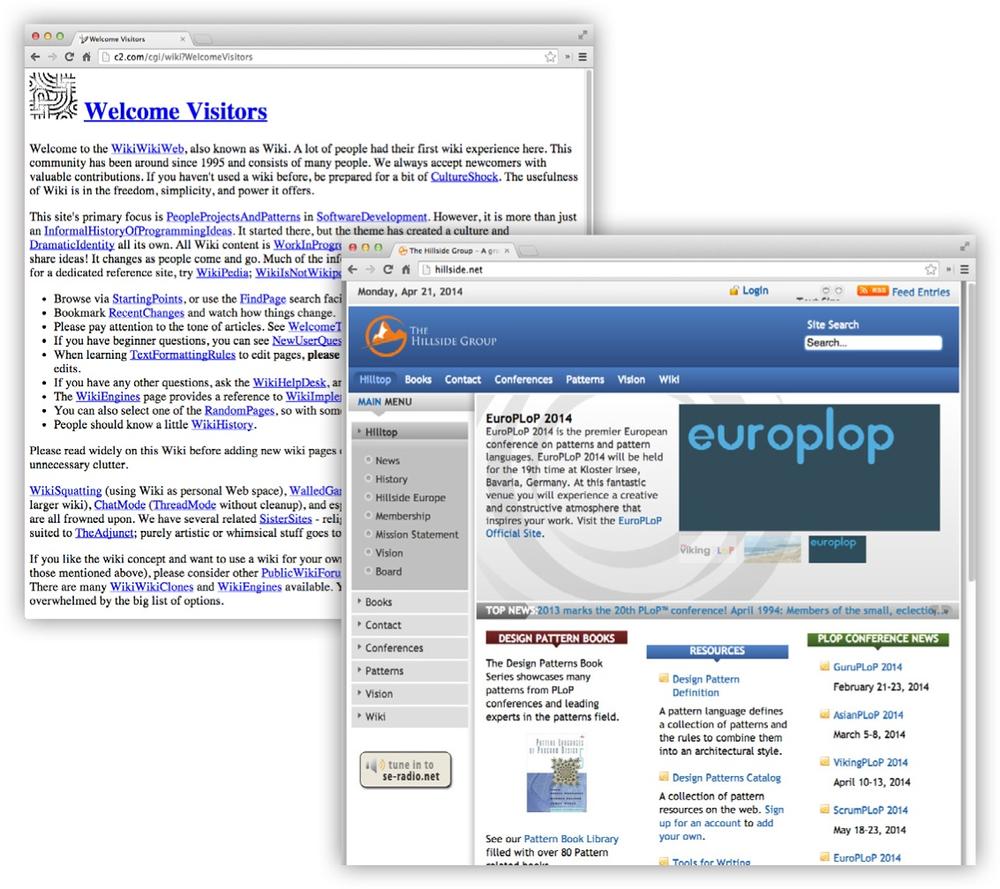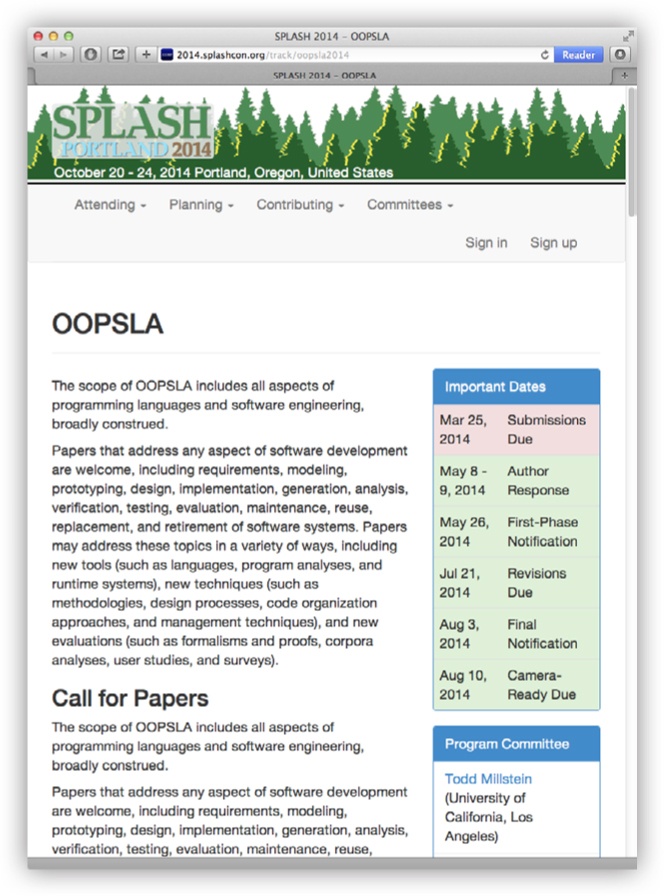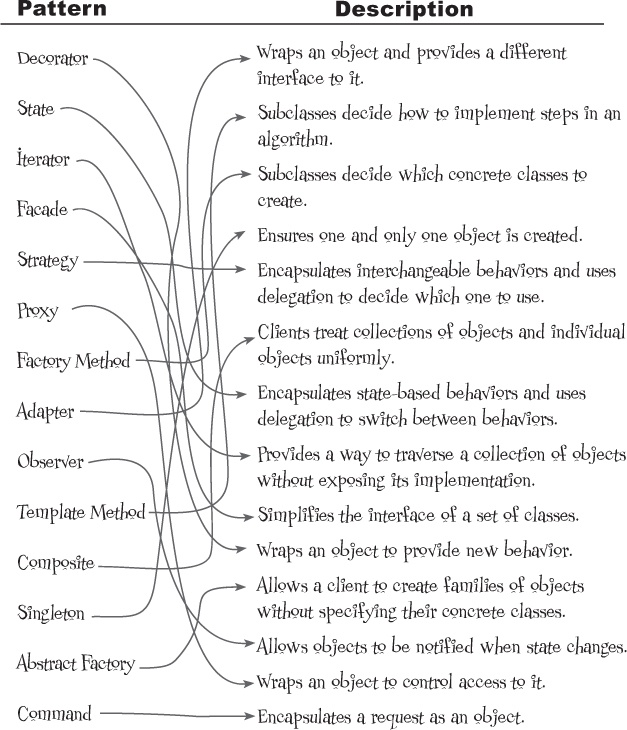Chapter 13. Better Living with Patterns: Patterns in the Real World
Ahhhh, now you’re ready for a bright new world filled with Design Patterns. But, before you go opening all those new doors of opportunity, we need to cover a few details that you’ll encounter out in the real world—that’s right, things get a little more complex than they are here in Objectville. Come along, we’ve got a nice guide to help you through the transition on the next page...
Design Pattern defined
We bet you’ve got a pretty good idea of what a pattern is after reading this book. But we’ve never really given a definition for a Design Pattern. Well, you might be a bit surprised by the definition that is in common use:
That’s not the most revealing definition is it? But don’t worry, we’re going to step through each of these parts: context, problem and solution:
The context is the situation in which the pattern applies. This should be a recurring situation.
The problem refers to the goal you are trying to achieve in this context, but it also refers to any constraints that occur in the context.
The solution is what you’re after: a general design that anyone can apply which resolves the goal and set of constraints.
This is one of those definitions that takes a while to sink in, but take it one step at a time. Here’s a little mnemonic you can repeat to yourself to remember it:
“If you find yourself in a context with a problem that has a goal that is affected by a set of constraints, then you can apply a design that resolves the goal and constraints and leads to a solution.”
Now, this seems like a lot of work just to figure out what a Design Pattern is. After all, you already know that a Design Pattern gives you a solution to a common recurring design problem. What is all this formality getting you? Well, you’re going to see that by having a formal way of describing patterns we can create a catalog of patterns, which has all kinds of benefits.
You might be right; let’s think about this a bit... We need a problem, a solution and a context:
Problem: How do I get to work on time?
Context: I’ve locked my keys in the car.
Solution: Break the window, get in the car, start the engine and drive to work.
We have all the components of the definition: we have a problem, which includes the goal of getting to work, and the constraints of time, distance and probably some other factors. We also have a context in which the keys to the car are inaccessible. And we have a solution that gets us to the keys and resolves both the time and distance constraints. We must have a pattern now! Right?
Looking more closely at the Design Pattern definition
Our example does seem to match the Design Pattern definition, but it isn’t a true pattern. Why? For starters, we know that a pattern needs to apply to a recurring problem. While an absent-minded person might lock his keys in the car often, breaking the car window doesn’t qualify as a solution that can be applied over and over (or at least isn’t likely to if we balance the goal with another constraint: cost).
It also fails in a couple of other ways: first, it isn’t easy to take this description, hand it to someone and have him apply it to his own unique problem. Second, we’ve violated an important but simple aspect of a pattern: we haven’t even given it a name! Without a name, the pattern doesn’t become part of a vocabulary that can be shared with other developers.
Luckily, patterns are not described and documented as a simple problem, context and solution; we have much better ways of describing patterns and collecting them together into patterns catalogs.
Geek Bits
The Design Pattern definition tells us that the problem consists of a goal and a set of constraints. Patterns gurus have a term for these: they call them forces. Why? Well, we’re sure they have their own reasons, but if you remember the movie, the force “shapes and controls the Universe.” Likewise, the forces in the pattern definition shape and control the solution. Only when a solution balances both sides of the force (the light side: your goal, and the dark side: the constraints) do we have a useful pattern.
This “force” terminology can be quite confusing when you first see it in pattern discussions, but just remember that there are two sides of the force (goals and constraints) and that they need to be balanced or resolved to create a pattern solution. Don’t let the lingo get in your way and may the force be with you!
Frank: Fill us in, Jim. I’ve just been learning patterns by reading a few articles here and there.
Jim: Sure, each patterns catalog takes a set of patterns and describes each in detail along with its relationship to the other patterns.
Joe: Are you saying there is more than one patterns catalog?
Jim: Of course; there are catalogs for fundamental Design Patterns and there are also catalogs on domain-specific patterns, like EJB patterns.
Frank: Which catalog are you looking at?
Jim: This is the classic GoF catalog; it contains 23 fundamental Design Patterns.
Frank: GoF?
Jim: Right, that stands for the Gang of Four. The Gang of Four are the guys that put together the first patterns catalog.
Joe: What’s in the catalog?
Jim: There is a set of related patterns. For each pattern there is a description that follows a template and spells out a lot of details of the pattern. For instance, each pattern has a name.
Frank: Wow, that’s earth-shattering—a name! Imagine that.
Jim: Hold on, Frank; actually, the name is really important. When we have a name for a pattern, it gives us a way to talk about the pattern; you know, that whole shared vocabulary thing.
Frank: Okay, okay. I was just kidding. Go on, what else is there?
Jim: Well, like I was saying, every pattern follows a template. For each pattern we have a name and a few sections that tell us more about the pattern. For instance, there is an Intent section that describes what the pattern is, kind of like a definition. Then there are Motivation and Applicability sections that describe when and where the pattern might be used.
Joe: What about the design itself?
Jim: There are several sections that describe the class design along with all the classes that make it up and what their roles are. There is also a section that describes how to implement the pattern and often sample code to show you how.
Frank: It sounds like they’ve thought of everything.
Jim: There’s more. There are also examples of where the pattern has been used in real systems, as well as what I think is one of the most useful sections: how the pattern relates to other patterns.
Frank: Oh, you mean they tell you things like how state and strategy differ?
Jim: Exactly!
Joe: So Jim, how are you actually using the catalog? When you have a problem, do you go fishing in the catalog for a solution?
Jim: I try to get familiar with all the patterns and their relationships first. Then, when I need a pattern, I have some idea of what it is. I go back and look at the Motivation and Applicability sections to make sure I’ve got it right. There is also another really important section: Consequences. I review that to make sure there won’t be some unintended effect on my design.
Frank: That makes sense. So once you know the pattern is right, how do you approach working it into your design and implementing it?
Jim: That’s where the class diagram comes in. I first read over the Structure section to review the diagram and then over the Participants section to make sure I understand each class’s role. From there, I work it into my design, making any alterations I need to make it fit. Then I review the Implementation and Sample code sections to make sure I know about any good implementation techniques or gotchas I might encounter.
Joe: I can see how a catalog is really going to accelerate my use of patterns!
Frank: Totally. Jim, can you walk us through a pattern description?
So you wanna be a Design Patterns writer
Do your homework. You need to be well versed in the existing patterns before you can create a new one. Most patterns that appear to be new, are, in fact, just variants of existing patterns. By studying patterns, you become better at recognizing them, and you learn to relate them to other patterns.
Take time to reflect, evaluate. Your experience—the problems you’ve encountered, and the solutions you’ve used—are where ideas for patterns are born. So take some time to reflect on your experiences and comb them for novel designs that recur. Remember that most designs are variations on existing patterns and not new patterns. And when you do find what looks like a new pattern, its applicability may be too narrow to qualify as a real pattern.
Get your ideas down on paper in a way others can understand. Locating new patterns isn’t of much use if others can’t make use of your find; you need to document your pattern candidates so that others can read, understand, and apply them to their own solution and then supply you with feedback. Luckily, you don’t need to invent your own method of documenting your patterns. As you’ve already seen with the GoF template, a lot of thought has already gone into how to describe patterns and their characteristics.
Have others try your patterns; then refine and refine some more. Don’t expect to get your pattern right the first time. Think of your pattern as a work in progress that will improve over time. Have other developers review your candidate pattern, try it out, and give you feedback. Incorporate that feedback into your description and try again. Your description will never be perfect, but at some point it should be solid enough that other developers can read and understand it.
Don’t forget the Rule of Three. Remember, unless your pattern has been successfully applied in three real-world solutions, it can’t qualify as a pattern. That’s another good reason to get your pattern into the hands of others so they can try it, give feedback, and allow you to converge on a working pattern.
Organizing Design Patterns
As the number of discovered Design Patterns grows, it makes sense to partition them into classifications so that we can organize them, narrow our searches to a subset of all Design Patterns, and make comparisons within a group of patterns.
In most catalogs, you’ll find patterns grouped into one of a few classification schemes. The most well-known scheme was used by the first patterns catalog and partitions patterns into three distinct categories based on their purposes: Creational, Behavioral, and Structural.
Pattern Categories
Here’s the grouping of patterns into categories. You probably found the exercise difficult, because many of the patterns seem like they could fit into more than one category. Don’t worry, everyone has trouble figuring out the right categories for the patterns.
Patterns are often classified by a second attribute: whether or not the pattern deals with classes or objects:
Thinking in Patterns
Contexts, constraints, forces, catalogs, classifications... boy, this is starting to sound mighty academic. Okay, all that stuff is important and knowledge is power. But, let’s face it, if you understand the academic stuff and don’t have the experience and practice using patterns, then it’s not going to make much difference in your life.
Here’s a quick guide to help you start to think in patterns. What do we mean by that? We mean being able to look at a design and see where patterns naturally fit and where they don’t.
Keep it simple (KISS)
First of all, when you design, solve things in the simplest way possible. Your goal should be simplicity, not “how can I apply a pattern to this problem?” Don’t feel like you aren’t a sophisticated developer if you don’t use a pattern to solve a problem. Other developers will appreciate and admire the simplicity of your design. That said, sometimes the best way to keep your design simple and flexible is to use a pattern.
Design Patterns aren’t a magic bullet; in fact, they’re not even a bullet!
Patterns, as you know, are general solutions to recurring problems. Patterns also have the benefit of being well tested by lots of developers. So, when you see a need for one, you can sleep well knowing many developers have been there before and solved the problem using similar techniques.
However, patterns aren’t a magic bullet. You can’t plug one in, compile and then take an early lunch. To use patterns, you also need to think through the consequences for the rest of your design.
You know you need a pattern when...
Ah... the most important question: when do you use a pattern? As you approach your design, introduce a pattern when you’re sure it addresses a problem in your design. If a simpler solution might work, give that consideration before you commit to using a pattern.
Knowing when a pattern applies is where your experience and knowledge come in. Once you’re sure a simple solution will not meet your needs, you should consider the problem along with the set of constraints under which the solution will need to operate—these will help you match your problem to a pattern. If you’ve got a good knowledge of patterns, you may know of a pattern that is a good match. Otherwise, survey patterns that look like they might solve the problem. The intent and applicability sections of the patterns catalogs are particularly useful for this. Once you’ve found a pattern that appears to be a good match, make sure it has a set of consequences you can live with and study its effect on the rest of your design. If everything looks good, go for it!
There is one situation in which you’ll want to use a pattern even if a simpler solution would work: when you expect aspects of your system to vary. As we’ve seen, identifying areas of change in your design is usually a good sign that a pattern is needed. Just make sure you are adding patterns to deal with practical change that is likely to happen, not hypothetical change that may happen.
Design time isn’t the only time you want to consider introducing patterns; you’ll also want to do so at refactoring time.
Refactoring time is Patterns time!
Refactoring is the process of making changes to your code to improve the way it is organized. The goal is to improve its structure, not change its behavior. This is a great time to reexamine your design to see if it might be better structured with patterns. For instance, code that is full of conditional statements might signal the need for the State Pattern. Or, it may be time to clean up concrete dependencies with a Factory. Entire books have been written on the topic of refactoring with patterns, and as your skills grow, you’ll want to study this area more.
Take out what you don’t really need. Don’t be afraid to remove a Design Pattern from your design.
No one ever talks about when to remove a pattern. You’d think it was blasphemy! Nah, we’re all adults here; we can take it.
So when do you remove a pattern? When your system has become complex and the flexibility you planned for isn’t needed. In other words, when a simpler solution without the pattern would be better.
If you don’t need it now, don’t do it now.
Design Patterns are powerful, and it’s easy to see all kinds of ways they can be used in your current designs. Developers naturally love to create beautiful architectures that are ready to take on change from any direction.
Resist the temptation. If you have a practical need to support change in a design today, go ahead and employ a pattern to handle that change. However, if the reason is only hypothetical, don’t add the pattern; it is only going to add complexity to your system, and you might never need it!
Your Mind on Patterns
The Beginner uses patterns everywhere. This is good: the beginner gets lots of experience with and practice using patterns. The beginner also thinks, “The more patterns I use, the better the design.” The beginner will learn this is not so, that all designs should be as simple as possible. Complexity and patterns should only be used where they are needed for practical extensibility.
As learning progresses, the Intermediate mind starts to see where patterns are needed and where they aren’t. The intermediate mind still tries to fit too many square patterns into round holes, but also begins to see that patterns can be adapted to fit situations where the canonical pattern doesn’t fit.
The Zen mind is able to see patterns where they fit naturally. The Zen mind is not obsessed with using patterns; rather it looks for simple solutions that best solve the problem. The Zen mind thinks in terms of the object principles and their trade-offs. When a need for a pattern naturally arises, the Zen mind applies it knowing well that it may require adaptation. The Zen mind also sees relationships to similar patterns and understands the subtleties of differences in the intent of related patterns. The Zen mind is also a Beginner mind—it doesn’t let all that pattern knowledge overly influence design decisions.
Note
WARNING: Overuse of design patterns can lead to code that is downright over-engineered. Always go with the simplest solution that does the job and introduce patterns where the need emerges.
Of course we want you to use Design Patterns!
But we want you to be a good OO designer even more.
When a design solution calls for a pattern, you get the benefits of using a solution that has been time-tested by lots of developers. You’re also using a solution that is well documented and that other developers are going to recognize (you know, that whole shared vocabulary thing).
However, when you use Design Patterns, there can also be a downside. Design Patterns often introduce additional classes and objects, and so they can increase the complexity of your designs. Design Patterns can also add more layers to your design, which adds not only complexity, but also inefficiency.
Also, using a Design Pattern can sometimes be outright overkill. Many times you can fall back on your design principles and find a much simpler solution to solve the same problem. If that happens, don’t fight it. Use the simpler solution.
Don’t let us discourage you, though. When a Design Pattern is the right tool for the job, the advantages are many.
Don’t forget the power of the shared vocabulary
We’ve spent so much time in this book discussing OO nuts and bolts that it’s easy to forget the human side of Design Patterns—they don’t just help load your brain with solutions, they also give you a shared vocabulary with other developers. Don’t underestimate the power of a shared vocabulary, it’s one of the biggest benefits of Design Patterns.
Just think, something has changed since the last time we talked about shared vocabularies; you’ve now started to build up quite a vocabulary of your own! Not to mention, you have also learned a full set of OO design principles from which you can easily understand the motivation and workings of any new patterns you encounter.
Now that you’ve got the Design Pattern basics down, it’s time for you to go out and spread the word to others. Why? Because when your fellow developers know patterns and use a shared vocabulary as well, it leads to better designs, better communication, and, best of all, it’ll save you a lot of time that you can spend on cooler things.
Top five ways to share your vocabulary
In design meetings: When you meet with your team to discuss a software design, use design patterns to help stay “in the design” longer. Discussing designs from the perspective of Design Patterns and OO principles keeps your team from getting bogged down in implementation details and prevent many misunderstandings.
With other developers: Use patterns in your discussions with other developers. This helps other developers learn about new patterns and builds a community. The best part about sharing what you’ve learned is that great feeling when someone else “gets it”!
In architecture documentation: When you write architectural documentation, using patterns will reduce the amount of documentation you need to write and gives the reader a clearer picture of the design.
In code comments and naming conventions: When you’re writing code, clearly identify the patterns you’re using in comments. Also, choose class and method names that reveal any patterns underneath. Other developers who have to read your code will thank you for allowing them to quickly understand your implementation.
To groups of interested developers: Share your knowledge. Many developers have heard about patterns but don’t have a good understanding of what they are. Volunteer to give a brown-bag lunch on patterns or a talk at your local user group.
Cruisin’ Objectville with the Gang of Four
You won’t find the Jets or Sharks hanging around Objectville, but you will find the Gang of Four. As you’ve probably noticed, you can’t get far in the World of Patterns without running into them. So, who is this mysterious gang?
Put simply, “the GoF,” which includes Erich Gamma, Richard Helm, Ralph Johnson and John Vlissides, is the group of guys who put together the first patterns catalog and in the process, started an entire movement in the software field!
How did they get that name? No one knows for sure; it’s just a name that stuck. But think about it: if you’re going to have a “gang element” running around Objectville, could you think of a nicer bunch of guys? In fact, they’ve even agreed to pay us a visit...
Your journey has just begun...
Now that you’re on top of Design Patterns and ready to dig deeper, we’ve got three definitive texts that you need to add to your bookshelf...
The definitive Design Patterns text
This is the book that kicked off the entire field of Design Patterns when it was released in 1995. You’ll find all the fundamental patterns here. In fact, this book is the basis for the set of patterns we used in Head First Design Patterns.
You won’t find this book to be the last word on Design Patterns—the field has grown substantially since its publication—but it is the first and most definitive.
Picking up a copy of Design Patterns is a great way to start exploring patterns after Head First.
The definitive Patterns texts
Patterns didn’t start with the GoF; they started with Christopher Alexander, a professor of architecture at Berkeley—that’s right, Alexander is an architect, not a computer scientist. Alexander invented patterns for building living architectures (like houses, towns and cities).
The next time you’re in the mood for some deep, engaging reading, pick up The Timeless Way of Building and A Pattern Language. You’ll see the true beginnings of Design Patterns and recognize the direct analogies between creating “living architecture” and flexible, extensible software.
So grab a cup of Starbuzz Coffee, sit back, and enjoy...
Other Design Patterns resources
You’re going to find there is a vibrant, friendly community of patterns users and writers out there and they’re glad to have you join them. Here are a few resources to get you started...
Websites
The Portland Patterns Repository, run by Ward Cunningham, is a wiki devoted to all things related to patterns. Anyone can participate. You’ll find threads of discussion on every topic you can think of related to patterns and OO systems.
http://c2.com/cgi/wiki?WelcomeVisitors
The Hillside Group fosters common programming and design practices and provides a central resource for patterns work. The site includes information on many patterns-related resources such as articles, books, mailing lists and tools.
http://hillside.net/
Conferences and Workshops
And if you’d like to get some face-to-face time with the patterns community, be sure to check out the many patterns-related conferences and workshops. The Hillside site maintains a complete list. At the least you’ll want to check out Pattern Languages of Programs (PLoP), and the ACM Conference on Object-Oriented Systems, Languages and Applications (OOPSLA).
The Patterns Zoo
As you’ve just seen, patterns didn’t start with software; they started with the architecture of buildings and towns. In fact, the patterns concept can be applied in many different domains. Take a walk around the Patterns Zoo to see a few...
Architectural Patterns are used to create the living, vibrant architecture of buildings, towns, and cities. This is where patterns got their start.
Application Patterns are patterns for creating system-level architecture. Many multi-tier architectures fall into this category.
Domain-Specific Patterns are patterns that concern problems in specific domains, like concurrent systems or real-time systems.
Note
Help find a habitat___________________
_____J2EE________________________
__________________________________
__________________________________
__________________________________
Business Process Patterns describe the interaction between businesses, customers and data, and can be applied to problems such as how to effectively make and communicate decisions.
Note
Help find a habitat__________
Development team_____________
Customer support team________
__________________________________
__________________________________
__________________________________
Organizational Patterns describe the structures and practices of human organizations. Most efforts to date have focused on organizations that produce and/or support software.
User Interface Design Patterns address the problems of how to design interactive software programs.
Note
Field notes: please add your observations of pattern domains here:
___________________________________________________________
___________________________________________________________
___________________________________________________________
___________________________________________________________
Annihilating evil with Anti-Patterns
The Universe just wouldn’t be complete if we had patterns and no anti-patterns, now would it?
If a Design Pattern gives you a general solution to a recurring problem in a particular context, then what does an anti-pattern give you?
You’re probably asking yourself, “Why on earth would anyone waste their time documenting bad solutions?”
Think about it like this: if there is a recurring bad solution to a common problem, then by documenting it we can prevent other developers from making the same mistake. After all, avoiding bad solutions can be just as valuable as finding good ones!
Let’s look at the elements of an anti-pattern:
An anti-pattern tells you why a bad solution is attractive. Let’s face it, no one would choose a bad solution if there wasn’t something about it that seemed attractive up front. One of the biggest jobs of the anti-pattern is to alert you to the seductive aspect of the solution.
An anti-pattern tells you why that solution in the long term is bad. In order to understand why it’s an anti-pattern, you’ve got to understand how it’s going to have a negative effect down the road. The anti-pattern describes where you’ll get into trouble using the solution.
An anti-pattern suggests other patterns that are applicable which may provide good solutions. To be truly helpful, an anti-pattern needs to point you in the right direction; it should suggest other possibilities that may lead to good solutions.
Let’s have a look at an anti-pattern.
An anti-pattern always looks like a good solution, but then turns out to be a bad solution when it is applied.
By documenting anti-patterns we help others to recognize bad solutions before they implement them.
Like patterns, there are many types of anti-patterns including development, OO, organizational, and domain-specific anti-patterns.
Tools for your Design Toolbox
You’ve reached that point where you’ve outgrown us. Now’s the time to go out in the world and explore patterns on your own...
Boy, it’s been great having you in Objectville.
We’re going to miss you, for sure. But don’t worry—before you know it, the next Head First book will be out and you can visit again. What’s the next book, you ask? Hmmm, good question! Why don’t you help us decide? Send email to [email protected].
